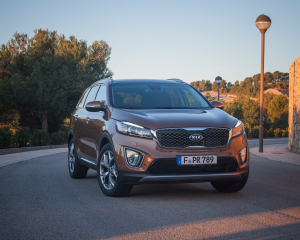Overview
- New design for third-generation Kia Sorento SUV
- All-new bodyshell improves ride, handling and crash safety
- Improvements to NVH and a step-change in interior quality and design
- Range of three improved gasoline and diesel engines for Europe
The designers of the third-generation Kia Sorento named their inspiration for the new car as ‘Streetwolf’. Although the styling changes are evolutionary, they subtly alter the character of the new Sorento, highlighting its sleek, sinuous, profile, as well as class-leading style and ensuring the new model has a bolder on-the-road presence.
The front of the new Sorento incorporates long, wrap-around headlamps and more prominent fog-lamps, as well as a larger, more upright ‘tiger-nose’ grille, with a distinctive three-dimensional diamond pattern, first featured on the 2013 Kia Cross GT concept.
In profile, the new model retains the Sorento’s hallmark long bonnet and characteristic wide D-pillar, but a lower roofline, higher beltline and swept-back shape give the car a more dramatic, muscular stance. This is aided by the more prominent ‘shoulders’ at the rear of the car.
For the first time in a new model from the brand, Kia has introduced a new laser welding manufacturing technique. This allows for closer body panel connections, enables Kia’s designers to introduce more advanced shapes to the bodywork and adds to a more premium, modern look and feel to the construction of the car.
The sleeker look of the new Sorento is enhanced by its increased length (+95 mm to 4,780 mm)*, reduced height (down 15 mm to 1,685 mm) and extra width (+5 mm to 1,890 mm).
The exterior styling of the new car was led by Kia’s Namyang design studio in Korea, with significant input from the brand’s Frankfurt, Germany and Irvine, California design studios.
‘Modern and wide’ theme for interior styling
Inside the all-new Sorento is where some of the most significant improvements are to be found. Interior styling was led by the brand’s European design team, based in Frankfurt, and Kia’s designers have created a more stylish, more luxurious cabin, featuring significantly higher quality materials.
The styling of the cabin follows a ‘modern and wide’ theme, providing the interior with a stable, horizontal layout and appearance. This width is echoed in the wider instrument cluster, interior garnish and the wrap-around shape of the dashboard which extends into the door trims. A higher proportion of soft-touch materials and leather creates a modern luxury feel to the cabin and gives the new Sorento a genuine premium vehicle ambience.
One of the most distinctive interior styling features is the Swiss watch-inspired user interface, which incorporates Kia’s latest HMI (human-machine interface) technologies, surrounded by new silver-look border.
The flowing contours of the dashboard rise to incorporate the driver’s instrument binnacle, while the smoothly-styled design curve in the doors, which leads from the audio speakers up to the SUV-style grab handles, also endows the cabin with a more luxurious appearance.
Customers will be able to specify the interior in either single-tone (black) or two-tone (black and stone beige) colour schemes with cloth or leather trim. Additionally, brown or light gray colour schemes in leather trim will be offered as an option.
Comfort, convenience and new technologies
Compared to the previous-generation model, the increased exterior dimensions and the extended wheelbase (+80 mm to 2,780 mm) have liberated additional space in the cabin of the new car.
Although the roofline is 15 mm lower, repositioned seat cushions ensure increased headroom for occupants in all three rows, who will also enjoy greater legroom. Cargo space also increases, with a longer cargo bay floor (up by 87 mm), and capacity with the third row seats folded flat up 17.5 percent, from 515 to 605 litres (VDA). The new Sorento also features a new under-floor tonneau cover storage compartment.
Available in 5- or 7-seat versions, the new Sorento features 40/20/40 second row split folding for improved versatility, with a higher folding centre armrest. The second row seats of the 7-seat version are equipped with ‘remote folding’ controlled by two levers in the side of the cargo bay, and also slide to allow easier entry and exit to the third row of seats.
The new Sorento debuts a number of new, advanced on-board technologies to improve convenience and further enhance the ownership experience. Depending on market, new available features will include: an Around-View Monitor, with four cameras helping the driver to manoeuvre when parking by displaying a birds-eye view of the vehicle on the dashboard display screen, and a Smart Power Tailgate. This system opens the tailgate automatically when the key is ‘sensed’ in close proximity to the trunk, so owners can slide their shopping bags or heavy objects straight into the vehicle.
Enhanced refinement
Throughout the development of the new Sorento, Kia engineers also focused on strengthening the bodyshell structure and improving NVH (noise, vibration and harshness) characteristics to increase refinement and create a tranquil travelling environment.
The increased torsional rigidity of the new bodyshell (up by 14 percent compared to the outgoing model) provides an excellent foundation for both enhanced refinement and improved safety.
NVH-reducing measures adopted for the new Sorento include new soundproofing material for the transmission tunnel, a 29 percent thicker dashboard soundproofing panel (increased from 0.7 mm to 0.9 mm), larger engine and transmission mounts for greater powertrain refinement and, for diesel models, a new DPF cover and an acoustic shield integrated into the engine’s timing chain cover. Cabin noise is reduced by 3-to-6 percent, depending on driving conditions.
Improved powertrains, ride and handling
To match consumers’ rising expectations, Kia engineers worked to improve every aspect of the new Sorento’s driving experience, creating upgrades for the engines, steering and suspension.
Three engines are available with the new Sorento, offering power outputs ranging from 185 to 200 ps. These include a 2.4-litre gasoline direct injection (GDI) unit, and two turbo-diesel engines, in 2.0-litre and 2.2-litre capacities, which are expected to account for the majority of European sales.
When developing the new Sorento, a key focus for the Kia chassis engineering team was achieving improvements in ride comfort, high-speed stability and handling response to match the leaps forward in interior quality and NVH.
The fully-independent suspension retains the format of the outgoing model (MacPherson struts at the front and Kia’s multi-link system at the rear), but features a range of modifications. At the rear, the subframe supporting the suspension has larger bushings to better isolate it from the cabin and the larger shock absorbers are now mounted vertically behind the axle line, improving body control motion.
These changes, together with the longer wheelbase, deliver a more compliant ride, with a more progressive response to bumps in the road, making the new Sorento a very comfortable place in which to spend time on longer journeys.
At the front, an all-new electric motor-driven power steering system (R-MDPS), available as standard across Europe, is mounted directly onto the steering rack – rather than the steering column as on the outgoing model. This provides greater steering feel and quicker response, ensuring that new Sorento will be among the more agile and sporty vehicles in its segment, without sacrificing the ride quality that customers expect from a luxurious SUV.
Improvements to fuel economy
Although the all-new Sorento has grown in size over the outgoing model and offers a great deal more in-car technology and improved safety credentials, Kia has been able to realise improvements to the car’s fuel economy and emissions.
The new vehicle’s base CO2 emissions start from 149 g/km for the 2.2-litre turbodiesel engine, expected to be the best-selling model in the Sorento range across Europe. This represents an improvement of 2.6 per cent, while fuel economy is improved by 1.7 per cent to 5.7 litres per 100 km (manual models on 17-inch wheels). The 2.0-litre turbodiesel boasts combined fuel economy of 6.7 litres per 100 km and CO2 emissions of 177 g/km, with the 2.4-litre GDI gasoline engine recording combined fuel economy of 8.8 litres per 100 km and emissions of 205 g/km (when equipped with an automatic transmission).
NOx and carbon monoxide emissions have also been reduced in both the 2.2- and 2.0-litre diesel engines. Every engine in the new Sorento range – including the 2.4-litre GDI gasoline power unit – complies with Euro Stage 6 emissions standards.
Better passive and active safety
The all-new Kia Sorento has been awarded the maximum five-star crash safety rating by Euro NCAP, scoring highly in all four areas (90% Adult Occupant Protection, 83% Child Occupant Protection, 67% Pedestrian Protection and 71% Safety Assist) thanks to an even stronger bodyshell and a wide array of passive and active safety equipment.
The Sorento was praised in particular for a passenger compartment that remained stable in the event of a collision, with good protection for passengers of different statures no matter where they were seated in the car. All passengers – including those in the third row of seats – were also well protected from whiplash, while pedestrian impact was aided by the Sorento’s active deployable bonnet.
The structure of the new Sorento is significantly stronger, thanks in large part to the more widespread use of ultra-high tensile steel. The previous-generation model was made up of 24.4 percent ultra-high tensile steel (UHTS), while the bodyshell of the new model consists of 52.7 percent UHTS, aiding the integrity of the car’s core structure in the event of an impact and also improving torsional rigidity. The stronger steel has been used to reinforce the wheel arches, tailgate surround and rear-wheel surround.
The new Sorento also features more than twice as much ultra-strong hot-stamped steel as the outgoing model, up from 4.1 percent to 10.1 percent in the new model, greatly strengthening the A- and B-pillars.
In the recent Euro NCAP safety test, the Sorento achieved a high score in the Safety Assist category. The new model’s standard-fit Vehicle Stability Management (VSM) system ensures the car remains stable when simultaneously braking and cornering, particularly on low-grip surfaces, by carefully controlling both the Electronic Stability Control (ESC) and electric motor-driven power steering. Both systems are activated as soon as the car’s sensors detect a loss in traction, helping the driver to remain safely in control of the vehicle.
Buyers of the new Sorento will be able to choose from a wealth of ‘active’ safety technologies – depending on market. Available systems will include: ASCC (Adaptive Smart Cruise Control); LDWS (Lane Departure Warning System), which emits an audible alert when the driver strays from the chosen lane without using indicators;; BSD (Blind-Spot Detection), with a visual warning in the door mirror when another car is in the driver’s blind spot; RCTA (Rear Cross-Traffic Alert), which warns against other cars driving behind the Sorento in car parks; and SLIF (Speed Limit Information Function), which displays the speed limit in the driver’s instrument cluster based on cameras detecting roadside signs.
New vehicle testing programme for Kia Sorento
The third-generation Sorento is the first Kia model to undergo testing and verification by the brand’s newly-launched Global Quality Centre, established to ensure that all new Kia vehicles are engineered, tested and manufactured to exceed customer expectations.
The development programme for the new model was carried out on a global scale, with over 1.1 million kilometres of durability testing carried out around the world – equivalent to approximately 27 circulations of the Earth around the Equator.
The car’s development took place across Europe, the Middle East, Asia and North and South America, for extreme climate testing and quality verification for all components used in the new Sorento. Tested for a global audience, the Sorento was subjected to extreme cold and heat and high altitude, and faced up to the unique demands of the desert, congested city centres, mountain passes and permafrost regions. Extensive testing was also carried out across Europe’s particularly diverse range of roads.
After the car’s worldwide programme for durability and testing, the Sorento was subjected to testing by Kia’s new Global Quality Centre, located at the brand’s Hwasung manufacturing facility in Korea, where the Sorento is manufactured for a number of markets, including Europe. This final stage of the Sorento’s development involved advanced component quality assessment and evaluation, and final vehicle testing in controlled conditions designed to emulate extreme high and low temperatures, humidity and wind speeds, as well as intense vibrations. This final level of assessment was carried out in conjunction with Kia’s suppliers, enabling both parties to benefit from any findings.
All Kia models undergo testing to ensure high durability in all conditions, but this is the most extensive qualitative evaluation ever carried out by the brand. All future Kia vehicles will be tested this way to ensure continuous improvements to vehicle quality and the brand’s reputation for producing cars that exceed buyers’ expectations.
As with every Kia sold in Europe, the all-new Sorento benefits from Kia’s unique 7-Year, 150,000 km warranty.
Editor’s notes
* Vehicle length dimensions are for the European specification model.
About Kia Motors Europe
Kia Motors Europe is the European sales, marketing and service arm of the Kia Motors Corporation. With its headquarters in Frankfurt, Germany, it covers 30 markets in Europe.
About Kia Motors Corporation
Kia Motors Corporation (www.kia.com) – a maker of quality vehicles for the young-at-heart – was founded in 1944 and is Korea's oldest manufacturer of motor vehicles. Over 2.7 million Kia vehicles a year are produced in 10 manufacturing and assembly operations in five countries which are then sold and serviced through a network of distributors and dealers covering around 150 countries. Kia today has around 48,000 employees worldwide and annual revenues of over US$43 billion. It is the major sponsor of the Australian Open and an official automotive partner of FIFA – the governing body of the FIFA World Cup™. Kia Motors Corporation's brand slogan – "The Power to Surprise" – represents the company's global commitment to surprise the world by providing exciting and inspiring experiences that go beyond expectations.
























































































